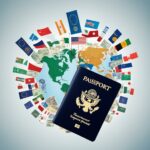Welcome to my guide on starting a local tour guide side business! If you have a passion for your city and love sharing its hidden gems with others, starting a tour company can be a fulfilling and profitable venture. However, it’s important to approach this endeavor with careful planning and preparation to ensure success. In this article, I will walk you through the necessary steps to kickstart your own tour business and make it a thriving enterprise.
Key Takeaways:
- Starting a tour company requires careful planning and preparation.
- Check the requirements with the local tour body to ensure compliance with health and safety regulations.
- Design your tour by choosing a target market, niche, and developing a unique selling point.
- Devise a go-to-market strategy and set the pricing for your tours.
- Identify the necessary resources and visualize a typical day running the tour.
Making a Commitment to Your Tour Business
Starting a tour business requires a long-term mindset and a commitment to putting in the time and effort required for success. It’s not a venture that will yield immediate results, but with dedication and perseverance, you can achieve your goals.
When I first started my own tour business, I understood that it would take days, months, and even years of hard work to grow it into something sustainable and profitable. However, I embraced this challenge and made a commitment to myself that I would do whatever it takes to make it a success.
Building a tour business from scratch is like planting a seed and watching it gradually grow into a beautiful tree. It requires patience, nurturing, and constant care. While it may seem overwhelming at times, maintaining a long-term mindset will keep you focused and motivated on your journey.
It’s important to approach your tour business with a sense of passion and purpose. Find joy in sharing your knowledge and showcasing the unique aspects of your city or area. This will serve as a driving force during times when the workload feels heavy.
Remember, success doesn’t happen overnight. Rome wasn’t built in a day, and neither will your tour business. Stay committed and persevere through challenges, setbacks, and the inevitable ups and downs. The journey will be worth it in the end.
Finding Balance
In order to maintain a long-term commitment to your tour business, it’s essential to find a balance between your work and personal life. While it’s natural to invest a significant amount of time and effort in the initial stages of building your business, it’s important to prioritize self-care and well-being.
By taking care of yourself physically and emotionally, you’ll be better equipped to handle the demands of running a tour business. Don’t neglect your hobbies, relationships, and interests outside of work. These aspects of your life will provide the necessary balance and rejuvenation to keep you motivated and inspired.
“Success is the sum of small efforts repeated day in and day out.” – Robert Collier
Remember, building a successful tour business is a marathon, not a sprint. Embrace the journey, stay committed, and be prepared to put in the time and effort required. With each small step forward, you’ll be one step closer to achieving your dream of running a thriving tour business.
Checking the Requirements
Before launching a tour company, it is crucial to check the requirements with the local tour body. This step ensures compliance with the necessary health and safety regulations, which may vary depending on the city and the type of tour being offered. By adhering to these requirements, you can operate your tour business legally and avoid any potential legal issues.
When starting a tour company, it is essential to prioritize the safety and well-being of both your customers and yourself. Understanding and complying with health and safety regulations not only protects you and your customers but also enhances your reputation as a trusted tour provider.
“Complying with health and safety regulations is not only a legal requirement but also essential for ensuring a positive and safe experience for your customers.”
The local tour body is responsible for setting and enforcing these regulations to maintain a high standard of quality and safety in the industry. They provide guidelines and requirements for tour operators to follow, helping to maintain the reputation of the local tourism sector.
By checking the requirements with the local tour body, you can ensure that your tour company meets all the necessary criteria and operates within the bounds of the law.
Below is a comprehensive table summarizing some of the common health and safety regulations that tour companies need to consider:
| Regulation | Description |
|---|---|
| First Aid and Emergency Preparedness | Ensuring the availability of first aid kits, trained staff, and emergency response plans. |
| Transportation Safety | Adhering to vehicle safety standards, driver qualifications, and passenger seatbelt requirements. |
| Facility and Equipment Safety | Maintaining safe and well-maintained facilities, equipment, and infrastructure for tours. |
| Risk Assessment and Management | Identifying potential risks and implementing measures to mitigate them, ensuring the safety of participants. |
| Insurance Coverage | Securing appropriate insurance coverage for potential liabilities and unforeseen circumstances. |
While this table provides a general overview, it is vital to consult the specific regulations provided by your local tour body to understand the requirements that apply to your tour business.
An image illustrating the importance of complying with health and safety regulations:
Adhering to health and safety regulations not only safeguards the well-being of your customers but also protects your business from potential legal consequences and reputational damage. By prioritizing compliance, you can create a safe and enjoyable experience for your customers while building a reputable tour company.
Designing Your Tour
When it comes to designing a tour, there are several factors to consider to ensure that it stands out in the market. Firstly, it’s crucial to identify your target market, that is, the specific group of people you want to attract with your tour. Knowing your audience will help you tailor your tour to their needs and interests, increasing its appeal. Once you have clarified your target market, you can then focus on finding your niche, which is a unique area or theme that sets your tour apart from others. This niche will be your tour’s selling point.
Creating a compelling value proposition is essential to attract customers. A value proposition is the promise of value that your tour offers to potential customers. It should address their pain points or goals and explain how your tour can provide a solution or help them achieve what they desire. A well-crafted value proposition should clearly communicate the benefits and advantages of choosing your tour.
“Our tour offers an immersive culinary experience, taking you on a journey through the hidden gems of local cuisine. Indulge in authentic flavors, discover the rich cultural history behind each dish, and connect with passionate local chefs. With our expert guides and carefully curated itinerary, we guarantee an unforgettable gastronomic adventure.”
A unique selling point (USP) further differentiates your tour from competitors and gives customers a compelling reason to choose you. It could be an exclusive feature, a one-of-a-kind experience, or exceptional customer service. Your USP is what makes your tour special and memorable.
By incorporating these elements into your tour design—target market, niche, value proposition, and unique selling point—you will create an irresistible offering that resonates with potential customers. Let’s take a look at some examples:
| Tour Company | Target Market | Niche | Value Proposition | Unique Selling Point |
|---|---|---|---|---|
| Taste of Tuscany | Food and wine lovers | Culinary tours in Tuscany | Authentic Tuscan gastronomy and wine paired with cultural insights | Hands-on cooking classes led by local chefs |
| Urban Adventures | Adventure seekers | Off-the-beaten-path city tours | Uncover hidden gems and local secrets with expert guides | Access to exclusive locations not typically visited by tourists |
| Historical Walks | History enthusiasts | Historical walking tours | Deep dive into the rich history and heritage of the city | Access to historical sites not open to the general public |
As you can see from these examples, designing a tour involves creating a unique and compelling experience for your target market. By understanding their needs, developing a strong value proposition, and highlighting your unique selling point, you can attract customers and stand out in the competitive tour market.
Tailoring Your Tour
When designing your tour, consider the following:
- Research your target market: Understand their demographics, interests, and preferences to tailor your tour accordingly.
- Plan an engaging itinerary: Incorporate exciting activities, insider knowledge, and unexpected surprises to captivate your audience.
- Emphasize local knowledge: Showcase your expertise and provide unique insights into the destination, making the tour a valuable learning experience.
- Ensure comfort and accessibility: Consider the physical abilities and comfort level of your target market, providing accessible routes and amenities.
Remember, designing a tour is about creating an unforgettable experience that exceeds customer expectations. By understanding your target market, developing a compelling value proposition, and highlighting your unique selling point, you can design a tour that captures the hearts and minds of your customers.
Choosing Your Market
When starting a tour company, one of the most important decisions you’ll make is choosing your target market. Understanding the needs and preferences of your potential customers is crucial for tailoring your tours and effectively reaching your audience. Conducting thorough market research is the key to acquiring valuable information about your target market.
Market research is a systematic process of gathering and analyzing data about the market you intend to serve. By conducting market research, you can gain insights into potential customers, their demographics, behaviors, and preferences. This information enables you to make informed decisions about the design, pricing, and promotion of your tours.
Identifying Potential Customers
Market research helps you identify your potential customers and understand their characteristics. By defining your target audience, you can focus your efforts on those who are most likely to be interested in and benefit from your tours. Consider factors such as age, location, interests, and travel preferences to create a clear profile of your ideal customer.
“By clearly defining your target audience, you can tailor your marketing efforts to reach them more effectively and maximize your business’s chances of success.” – [Expert Name, Tour Business Consultant]
Understanding How Customers Acquire Information
In addition to understanding the characteristics of your potential customers, it is important to know how they acquire information. Do they rely on social media, search engines, travel blogs, or word-of-mouth recommendations? By identifying the channels they use to gather information, you can strategically position your marketing efforts and reach your target audience more effectively.
For example, if your target market consists of younger travelers who are active on social media, you can allocate more resources to promoting your tours on platforms like Instagram and Facebook. On the other hand, if your target market includes older travelers who prefer traditional print media, investing in advertisements in travel magazines may be more effective.
Making Informed Decisions
By conducting market research and acquiring information about your potential customers, you can make informed decisions about every aspect of your tour business. From developing tour itineraries that align with customer preferences to setting competitive pricing, market research provides you with valuable insights and data-driven guidance.
Market research can also help you identify gaps in the market and uncover opportunities for innovation. Perhaps there is a specific type of tour that no other company in your area offers, or you may discover an underserved niche that has high demand. By understanding the market landscape, you can position your business strategically and differentiate yourself from competitors.
Choosing your target market through market research lays the foundation for success in the tour business. It enables you to tailor your tours and marketing efforts to meet the specific needs and preferences of your customers. By understanding your target market and acquiring relevant information, you increase your chances of attracting and retaining loyal customers.
Developing Your Value Proposition
When starting a tour business, it’s essential to develop a strong value proposition that resonates with your ideal customers. Understanding their pains, gains, and aspirations will help you create a tour that solves their problems and helps them reach their goals.
By identifying the unique benefits your tour offers, you can effectively communicate its value to potential customers. Consider what sets your tour apart from competitors and how it addresses the specific needs and desires of your target audience.
“Our guided tours offer a personalized and immersive experience that allows you to discover the hidden gems of our city. With knowledgeable guides and carefully curated itineraries, we take care of all the planning, so you can focus on creating meaningful memories.”
Through our tours, we aim to address the pain points that travelers often face, such as the hassle of planning, the fear of missing out on the best attractions, and the difficulty of truly understanding the local culture. Our goal is to provide a seamless and enriching experience that leaves you with a deeper connection to the city and its people.
Customer Pains and Gains
By understanding your customers’ pains, you can tailor your tour to alleviate their concerns and provide solutions. Some common customer pains in the tourism industry include:
- Uncertainty about the best places to visit
- Lack of local knowledge
- Language barriers
- Confusion and overwhelm when navigating a new city
On the other hand, consider the gains your customers hope to achieve through your tour. These may include:
- Discovering hidden local gems
- Learning about the history and culture of the city
- Creating memorable experiences
- Connecting with like-minded travelers
Our carefully designed tours address these pains and provide the following gains:
| Pains | Gains |
|---|---|
| Uncertainty about the best places to visit | Discover hidden local gems |
| Lack of local knowledge | Learn about the history and culture of the city |
| Language barriers | Connect with like-minded travelers |
| Confusion and overwhelm when navigating a new city | Create memorable experiences |
By addressing these customer pains and offering corresponding gains, we strive to create a tour that exceeds expectations and delivers an exceptional experience.
Identifying Your Unique Selling Point (USP)
When starting a tour business, it’s crucial to identify your unique selling point (USP) that sets your tour apart from competitors and gives customers a reason to choose you. Your USP can be a distinct feature or offering that makes your tour stand out in the market.
One way to differentiate your tour is by offering something that no one else does in your city. This could be a special landmark or attraction that is exclusive to your tour, providing customers with a one-of-a-kind experience they can’t find elsewhere.
Another approach is to provide exceptional value at the same price as your competitors. This could include additional inclusions or amenities that enhance the overall tour experience, making it more appealing to potential customers.
Additionally, you can have a unique tour theme that caters to a specific niche or interest. By focusing on a specific theme, such as history, art, food, or adventure, you can attract a targeted audience that shares a common passion and create a memorable and tailored experience for them.
“Our tour stands out by offering exclusive access to hidden gems in the city, allowing our customers to discover breathtaking views and stories that are unique to our tour.”
By identifying your USP, you can effectively market your tour and attract customers who are looking for something different and memorable. Emphasize your USP in your marketing materials, website, and social media channels to showcase the value and differentiation your tour brings to the table.
Highlighting the Unique Selling Point:
- Exclusive access to hidden gems in the city
- Enhanced value with additional inclusions
- A tailored tour theme catering to specific interests
Devising a Go-to-Market Strategy
When it comes to starting a tour company, devising a go-to-market strategy is essential for reaching your target audience and maximizing your success. By identifying the most cost-effective channels to promote your tours, you can effectively connect with potential customers and generate bookings. Here are some key steps to help you create an impactful go-to-market strategy:
1. Research Your Target Audience
Understanding your target audience is crucial for identifying the best channels to reach them. Conduct thorough market research to gain insights into their demographics, interests, and preferences. This will enable you to tailor your marketing messages and choose the most effective channels to engage with them.
2. Identify Cost-effective Channels
Once you have a clear understanding of your target audience, explore various marketing channels to determine which ones are the most cost-effective for your tour business. Consider using websites, social media platforms, and partnering with other businesses to promote your tours. Implementing a mix of online and offline channels can help you reach a wider audience while optimizing your marketing budget.
3. Create Compelling Content
Engaging content is the key to capturing your audience’s attention and driving bookings. Develop captivating descriptions of your tours that highlight their unique features and value. Utilize high-quality images, videos, and testimonials to showcase the experience customers can expect. By creating compelling content, you can effectively communicate your tour’s value proposition and generate interest.
4. Implement Search Engine Optimization (SEO)
Optimizing your website and content for search engines is crucial for increasing your online visibility and attracting organic traffic. Conduct keyword research to identify relevant terms that potential customers may use when searching for tours in your area. Incorporate these keywords into your website copy, meta tags, and blog articles to improve your search engine rankings.
5. Leverage Influencer Marketing
Partnering with influencers in your niche can help you expand your reach and build credibility. Identify influential travel bloggers, vloggers, or social media personalities who align with your target audience and collaborate with them to promote your tours. Their endorsements and recommendations can significantly impact the decision-making process of potential customers.
“By choosing the right channels and implementing a well-rounded go-to-market strategy, you can effectively reach your target audience and promote your tour business.”
Remember, an effective go-to-market strategy requires continuous monitoring and optimization. Regularly track the performance of your marketing efforts, analyze the data, and make adjustments as needed. Stay agile in adapting your strategy to ensure you’re always reaching your target audience and driving bookings.
| Marketing Channel | Advantages | Disadvantages |
|---|---|---|
| Websites |
|
|
| Social Media |
|
|
| Partnerships |
|
|
Setting Your Price
When it comes to starting a tour business, setting the right price is crucial for attracting customers and generating revenue. A strategic pricing strategy can help position your tour as a valuable experience while still remaining competitive in the market. In this section, I will discuss the importance of considering the perceived value of your tour, analyzing the competition, and implementing multiple pricing tiers to cater to different customer preferences.
Perceived Value of Your Tour
Perceived value plays a significant role in influencing customers’ willingness to pay for your tour. It refers to the customer’s perception of the benefits they will receive in relation to the price they will pay. To determine the perceived value of your tour, consider the unique experiences, exclusive access, and expert guidance that sets your tour apart from others. Highlighting these special features in your marketing materials and emphasizing the value customers will gain can justify a higher price for your tour.
Competition Analysis
Understanding the pricing strategies of your competitors is essential for positioning your tour in the market effectively. Research other tour companies in your area and identify their pricing tiers, target audience, and the value they offer. Compare their offerings to yours and find opportunities to differentiate your tour. Consider offering additional services or amenities, such as complimentary snacks or a personalized souvenir, to make your tour stand out from the competition.
Researching your competitors and identifying their pricing strategies can provide valuable insights for setting your own prices. Remember, the goal is not to undercut your competition but to offer a unique value proposition that justifies your price point.
Implementing Multiple Pricing Tiers
People have different preferences and budgets when it comes to tours. By offering multiple pricing tiers, you can appeal to a wider range of customers and increase the chances of conversion. Consider creating tiers based on the level of service, duration of the tour, or additional add-ons. This allows customers to choose the package that best suits their needs and budget, providing flexibility while driving revenue for your business.
To illustrate multiple pricing tiers, here is an example:
| Tier | Description | Price |
|---|---|---|
| Standard | A guided tour with a duration of 2 hours | $30 |
| Premium | A guided tour with a duration of 3 hours and complimentary snacks | $45 |
| Deluxe | A private guided tour with a duration of 4 hours, complimentary snacks, and a personalized souvenir | $65 |
By offering multiple pricing tiers, you can accommodate different customer preferences while optimizing your revenue streams.
Setting the right price for your tour is a delicate balance between providing value to customers and ensuring the profitability of your business. Taking into account the perceived value, competition, and implementing multiple pricing tiers can help you find the sweet spot that attracts customers and keeps your tour business thriving.

Identifying Resources Needed
When starting a tour business, it is crucial to identify the required resources in order to estimate costs and plan your budget effectively. These resources may include special equipment, assets, employees, and an office location. By understanding and budgeting for these resources, you can ensure that you have the necessary funds and support to run your tour successfully.
Let’s take a closer look at the key resources you need to consider:
1. Special Equipment
Depending on the type of tour you offer, special equipment may be necessary to enhance the customer experience and deliver a high-quality service. This could include audio devices for guided tours, bicycles for cycling tours, or safety gear for adventure tours. Consider researching and investing in reliable equipment that aligns with the unique aspects of your tour.
2. Assets
Assets are tangible resources that contribute to the operation of your tour business. For example, if you plan to run a sightseeing tour, you may require vehicles or boats. If you offer food tasting tours, you may need to secure agreements with local restaurants. Identify the specific assets that are essential to delivering your tour and factor them into your budget.
3. Employees
As your tour business grows, you may need to hire employees to assist with various aspects of the operation. This could include tour guides, customer service representatives, or administrative staff. Consider the number of employees you will need, their roles and responsibilities, and the associated costs such as salaries, benefits, and training.
4. Office Location
Having a physical office location can provide a central hub for managing your tour business operations. Depending on the size and nature of your business, you may require a dedicated office space. Alternatively, you could consider shared office spaces or remote working arrangements. Evaluate the needs of your business and choose an office location that aligns with your budget and accessibility requirements.
By considering these resources and estimating the associated costs, you’ll be able to create a comprehensive budget for your tour business. This will help you make informed decisions, allocate funds effectively, and ensure a smooth operation.
To provide a visual representation of the resources needed to start a tour business, here is a table summarizing the key elements:
| Resources | Description |
|---|---|
| Special Equipment | Audio devices, bicycles, safety gear, etc. |
| Assets | Vehicles, boats, agreements with local establishments |
| Employees | Tour guides, customer service representatives, administrative staff |
| Office Location | Physical office space or remote working arrangements |
Visualizing a Day Running the Tour
When running a tour, it’s essential to have a clear vision of what a typical day looks like and understand the tasks and responsibilities involved. Visualizing your daily routine helps identify any gaps or missed opportunities, ensuring that all aspects of the tour are considered.
As a tour guide, my day begins with preparations before the tour starts. This includes checking the equipment, ensuring everything is in working order, and gathering any necessary materials or props. It’s important to be organized and have everything ready to deliver a seamless experience for the participants.
Once the tour begins, my role as a guide comes into play. I am responsible for leading the group, providing interesting and informative commentary, and answering any questions they may have. Engaging with the participants and creating a friendly and welcoming atmosphere is crucial to delivering a memorable experience.
Throughout the tour, I keep a close eye on the group, ensuring everyone stays together and no one gets left behind. Safety is a top priority, so I make sure to adhere to any health and safety guidelines to protect both the participants and myself.
Moreover, I constantly evaluate the participants’ engagement levels and adjust my delivery accordingly. This involves gauging their interests, adapting the content, and finding opportunities to spark their curiosity. By doing so, I ensure that the tour remains enjoyable and valuable for everyone involved.
Additionally, I keep an eye out for any gaps or missed opportunities during the tour. Whether it’s a scenic spot that could be highlighted better or an interaction that could be enhanced, I strive to identify areas for improvement and make necessary adjustments to provide the best experience possible.
To give you a better idea of what a typical day running the tour entails, here is a breakdown of the tasks and responsibilities:
| Task | Responsibility |
|---|---|
| Pre-tour preparations | Checking equipment, gathering materials, and ensuring readiness |
| Tour guiding | Leading the group, providing commentary, answering questions |
| Group management | Ensuring participant safety, keeping the group together |
| Engagement evaluation | Assessing participant engagement levels, adapting delivery |
| Identifying gaps and missed opportunities | Maintaining vigilance for improvement prospects during the tour |
By visualizing a day running the tour, I can proactively address any challenges that may arise and optimize the experience for the participants. This allows me to deliver a tour that exceeds expectations and leaves a lasting impression.
Making a List of People Who Can Help
Building a strong network of individuals, organizations, and businesses who can offer guidance, support, and resources is crucial for the success of your tour business. By establishing these connections, you can access valuable insights, collaborations, and opportunities that can propel your business forward. Networking allows you to tap into the knowledge and experience of others who have already navigated the challenges you may face as a tour guide entrepreneur.
There are several ways you can start building your networking circle:
- Attend industry events and conferences:
- Join online communities and forums:
- Seek guidance from local tourism organizations:
Participating in relevant industry events and conferences is an excellent way to connect with like-minded individuals and organizations. These gatherings provide opportunities to exchange ideas, share experiences, and establish mutually beneficial relationships. Stay updated on upcoming events through industry websites, social media groups, and professional associations.
Virtual communities and forums specific to the tour guide or travel industry offer a platform to interact with professionals from around the world. By actively engaging in discussions, asking questions, and sharing your experiences, you can establish connections and gain valuable insights. Platforms such as LinkedIn, Facebook groups, and specialized travel forums are great places to start.
Contact local tourism organizations, such as visitor bureaus and tourism development councils, to seek guidance and support. These organizations often offer resources, educational programs, and networking opportunities specifically tailored to the needs of tour businesses. Attend their seminars, workshops, and webinars to expand your knowledge and network.
Remember, networking is a two-way street. It’s not just about asking for help, but also offering support and assistance to others in your network. By actively engaging and providing value to your connections, you cultivate meaningful relationships that can lead to partnerships, collaborations, and referrals.
“Networking is about creating long-term relationships with a mutual commitment to helping one another reach their goals.” – Richard Branson
By leveraging networking opportunities, you can gain valuable guidance, support, and resources that can make a significant difference in the success of your tour business. Cultivating a strong network of connections will open doors to partnership opportunities, industry insights, and shared experiences.
Building Partnerships for Success
In addition to networking, building partnerships with relevant organizations and businesses can be mutually beneficial for both parties. Seeking partnerships allows you to expand your reach, tap into new customer segments, and access additional resources. Here are some strategies to consider:
- Collaborate with local attractions and landmarks:
- Establish relationships with local hotels and accommodations:
- Connect with complementary businesses:
Partnering with popular local attractions and landmarks can create unique tour offerings and increase your visibility. You can negotiate package deals or joint marketing campaigns to attract tourists who are interested in exploring multiple attractions.
By forging partnerships with hotels and accommodations, you can offer exclusive tour packages to their guests. This collaboration allows you to tap into a ready-made customer base and provide added value to their experience.
Identify businesses that offer complementary services or products to your tours and explore partnership opportunities. For example, if you provide historical tours, consider connecting with local souvenir shops or restaurants that have a historical theme. Co-marketing initiatives and cross-promotions can benefit both businesses and attract customers who are interested in a holistic experience.
Remember, partnerships should be mutually beneficial. When approaching potential partners, clearly outline the value you can bring to their business and demonstrate how collaborating with you aligns with their goals. Building strong relationships through partnerships can significantly enhance the visibility and reputation of your tour business.
Estimating Your Costs
When starting and running a tour business, it’s crucial to estimate the costs involved for effective budgeting and financial planning. By considering both upfront costs and monthly overhead, you can make informed decisions and avoid unexpected surprises.
Upfront Costs
Upfront costs include expenses that you’ll need to pay before launching your tour business. These may vary depending on the nature of your tours and specific requirements. Some common upfront costs to consider are:
- Equipment: This includes any specialized equipment or gear needed for your tours, such as bicycles, audio guides, or vehicles.
- Registration Fees: Depending on your location and the type of tours you offer, there may be registration or licensing fees required by local authorities or tourism organizations.
- Marketing Collateral: To promote your tours effectively, you may need to invest in professional brochures, flyers, or signage.
- Website Development: Creating a user-friendly website where customers can access information and make bookings is essential for modern tour businesses.
Monthly Overhead
Monthly overhead costs are the ongoing expenses necessary to operate your tour business. These costs may vary based on factors such as the size of your operation and the location. Some typical monthly overhead costs to consider are:
- Rent: If you require office or storage space, factor in the cost of rent or lease payments.
- Employee Wages: If you plan to hire staff, ensure you allocate funds for salaries, benefits, and payroll taxes.
- Marketing Expenses: Marketing plays a crucial role in attracting customers. Consider costs for online advertising, social media promotion, and print materials.
- Insurance: Protecting your business with liability insurance coverage is essential in the event of accidents or claims.
- Utilities: Allocate funds for utilities such as electricity, water, and internet services.
| Cost Category | Examples |
|---|---|
| Upfront Costs |
|
| Monthly Overhead |
|
Estimating your costs accurately will help you create a realistic budget and ensure the financial sustainability of your tour business. Keep in mind that these costs may vary depending on your location, target market, and specific business needs. Conduct thorough research and consult with industry professionals or mentors to gain insights into typical expenses in the tour industry.
I’m here to help you navigate the financial aspects of your tour business. Let’s dive deeper into budgeting and cost estimation in the next section!
Conclusion
Starting a tour company requires careful planning and preparation, as well as a commitment to the long-term success of the business. By following the steps outlined in this article, you can lay the foundation for a successful tour business.
Thoroughly researching your target market is essential, as it helps you understand their needs and preferences. This enables you to develop a compelling value proposition and unique selling point that sets your tour company apart from competitors. Additionally, consider your pricing strategy carefully to ensure it reflects the value you offer while remaining competitive.
It’s also important to identify the necessary resources, such as special equipment, employees, and an office location, and estimate the costs involved in starting and running your tour business. Visualizing a typical day running the tour can help you identify any gaps or missed opportunities and streamline your operations.
With dedication and hard work, you can turn your passion for your city into a profitable tour guide business. By taking the time to plan, research, and execute your business idea, you can create memorable experiences for your customers while building a successful venture for yourself.
FAQ
How do I start a local tour guide side business?
What is the first step in starting a tour company?
How do I design a tour?
How do I choose my target market?
What is a value proposition?
How do I identify my unique selling point (USP)?
How do I devise a go-to-market strategy?
How do I set the right price for my tour?
How do I identify the resources needed for my tour?
Why is it important to visualize a typical day running the tour?
How can I build a network of people who can help with my tour business?
How do I estimate the costs of starting and running my tour business?
Source Links
- https://www.checkfront.com/blog/how-to-start-a-tour-operator-business/
- https://pro.regiondo.com/blog/how-to-start-a-tour-company/
- https://www.sidehustlenation.com/getting-paid-show-off-city/
Money posts:
 22 Best Ways to Travel and Make Money in 2024
22 Best Ways to Travel and Make Money in 2024
 17 Easy Jobs That Pay Well (2024)
17 Easy Jobs That Pay Well (2024)
 29 Creative Ways to Make Money in 2024
29 Creative Ways to Make Money in 2024
 21 Ways to Get Paid to Travel the World in 2024
21 Ways to Get Paid to Travel the World in 2024
 15 Ways to Get Paid to Ride Your Bike in 2024
15 Ways to Get Paid to Ride Your Bike in 2024
 22 Best Ways to Get Paid to Travel the World (2024)
22 Best Ways to Get Paid to Travel the World (2024)
 21 Ways to Get Paid to Walk (2024)
21 Ways to Get Paid to Walk (2024)
 14 Best Summer Jobs for Teachers (From a Former Teacher!) (2024)
14 Best Summer Jobs for Teachers (From a Former Teacher!) (2024)

